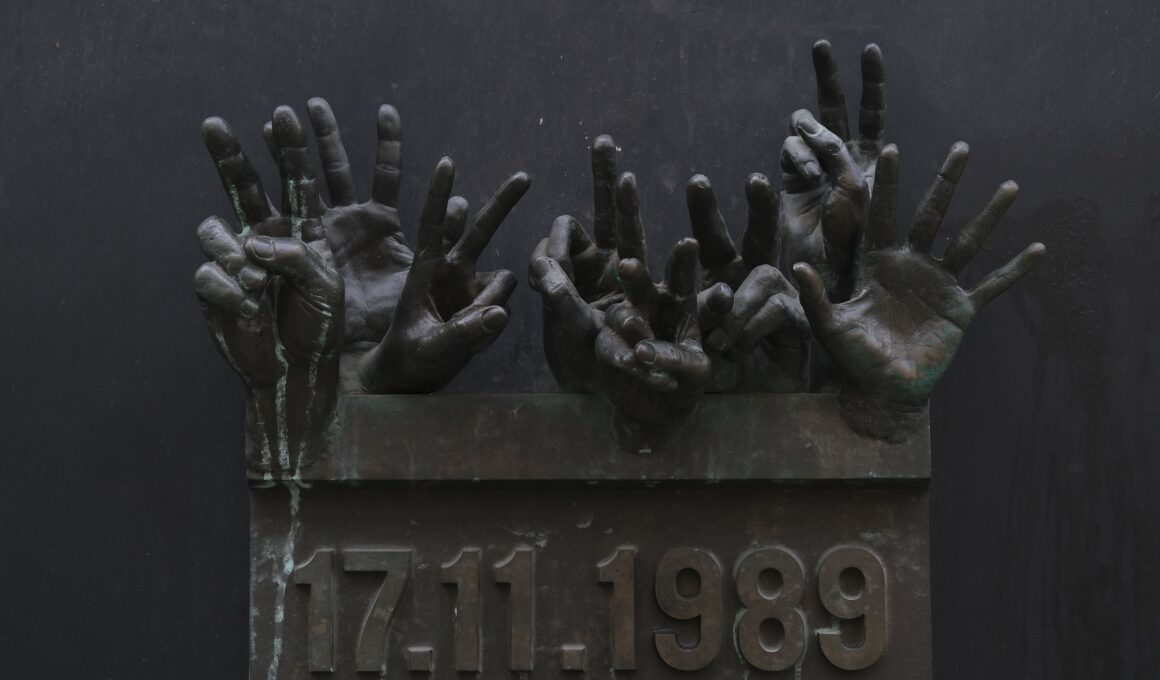Table of contents Show
The 1989 Czech Velvet Revolution was an important turning point in the annals of Eastern European history that changed the course of Czechoslovakia and its people’s lives forever. Envision a world where the weight of the state’s fear weighs heavily on everyone’s shoulders, and where speaking out may lead to unfathomable repercussions. Join us as we trace the events that led to the 1989 Czech Velvet Revolution.
1989 is a turning point in Czechoslovakia’s history, a year of tremendous political turmoil, social revolution, and the victory of the people’s will.
Additionally, the 1989 Czech Velvet Revolution, with all its breathtaking turns and twists, represents the pinnacle of an unquenchable thirst for freedom.
A Complete Exploration Of 1989 in Czechoslovakia

As communism crumbled and a new era began in Czechoslovakia in 1989, it was an iconic year. By delving into this formative era, we can see the intriguing cultural, political, and social changes that set the stage for a thriving democratic nation. Come along as we explore the inside of the 1989 Czechoslovakia time capsule and learn all about its historical artifacts.
The Spark: November 17th and Student Protests
The spark for change happened on November 17, 1989, during a nonviolent student demonstration to commemorate International Students’ Day. What began as a memory of historical events has evolved into a forceful demonstration of displeasure with the Communist regime. The savage suppression of student riots by authorities sparked a wave of popular discontent, resulting in massive rallies across the country.
Civic Forum and Call for Transformation
Civic Forum developed from the demonstrations as a broad combination of dissidents, academics, and concerned people. The Civic Forum, headed by Václav Havel and Jiří Dienstbier, made unambiguous requests for the cessation of one-party rule, free and fair elections, and a democratic administration. The movement acquired widespread support, tearing apart the tightly woven threads of Communist authority.
A massive uprising and the downfall of the Communist regime
The streets of Prague and other towns became the site of large rallies, attracting individuals from all walks of life to rally for change. The Communist administration, unable to stem the tide of unrest, resigned at the beginning of December 1989. President Gustáv Husák formed a new cabinet composed of Civic Forum members, marking the end of Communist control.
Václav Havel’s Administration and The Velvet Split
On December 29, 1989, Václav Havel, a rebel writer turned politician, became Czechoslovakia’s president. His rise from political detainee to head of state exemplified the Velvet Revolution’s success. The year 1989 also laid the groundwork for the orderly split of Czechoslovakia into the Czech Republic and Slovakia in 1993, dubbed the Velvet Divorce.
Legacy and Global Implications
The upheavals of 1989 in Czechoslovakia had a lasting impact. The Velvet Revolution remained a symbol of peaceful protest, encouraging freedom and democracy movements around the world. Václav Havel’s administration marked a period of ethical governance, and the shift from Communism to Democracy demonstrated the human spirit’s endurance.
A Turning Point Caused by the Velvet Revolution in Czechoslovakia
The Velvet Revolution in the Czech republic marked an important moment that resulted in significant internal and international transformations. The significant turning points triggered by the Velvet Revolution are:
End of Communist Rule
The 1989 Czech Velvet Revolution had the most rapid and substantial impact on Czechoslovakia, bringing an end to decades of Communist tyranny. The Communist administration fell in December 1989, pressured by massive demonstrations and the Civic Forum. It marked the very first time in over forty years that the entire nation was not under Communist rule.
Establishment of Democratic Governments
The departure of the Communist government allowed for the formation of a new government composed of Civic Forum representatives and other opposition groupings. Václav Havel, a notable rebel and playwright, was elected president, ushering in an age of democracy.
Transition to the market economy
The fall of Communist in Czech control signaled the move towards a market-oriented economy. Czechoslovakia started its journey of economic reform, moving from a tightly controlled system to a more democratic and market-driven economy. This move had long-term effects on the nation’s economic development.
Peaceful disintegration of Czechoslovakia
The Velvet Revolution in Czechoslovakia in 1989 laid the groundwork for Czechoslovakia’s peaceful separation into two distinct countries—the Czech Republic and Slovakia—in 1993. The Velvet Divorce, as it became known, demonstrated the capacity of the two recently constituted nations to split ways peacefully, prioritizing diplomacy rather than conflict.
Motivation for democratic movements
The Velvet Revolution inspired demonstrations for democracy around the globe. The peaceful and effective collapse of a Communist administration without resorting to violence established a precedent for nonviolent opposition. It caused a rippling effect throughout Eastern Europe, encouraging other governments to undertake democratic reforms.
Integration with the European Community
The Velvet Revolution’s democratization cleared the path for Czechoslovakia’s membership in the European Community. The nation actively pursued stronger links with Western Europe and ultimately joined the European Union in 2004.
Symbolism for Hope and Human Rights
The 1989 Czech Velvet Revolution was a symbol of optimism, demonstrating the capacity of the people to effect reform through peaceful methods. It emphasized the value of human rights, free expression, and democracy. Václav Havel’s presidency exemplified these ideals, and the Velvet Revolution’s impact continues to motivate movements for liberty and justice.
End of Cold War Era
The Velvet Revolution was crucial in the bigger picture of the Cold War’s ending. It contributed to the downfall of Communist regimes in other Eastern European countries and marked the end of Soviet influence in the region.
In summary, the Velvet Revolution was an important turning point that not only revolutionized Czechoslovakia within but also left an indelible mark on the world stage. It highlighted the possibility of peaceful change and laid the groundwork for the country’s transformation into a democratic and economically prosperous nation.
From the Uprising to the Freedom of the Velvet Revolution in Czechoslovakia 1989
The streets of Czechoslovakia resounded in the autumn of 1989 with the demands of a people eager for transformation.
The road from the November 17, 1989, revolt to the Velvet Revolution, which brought about freedom, is a story of a people who were determined to have their freedom. From the beginnings of dissatisfaction to the eventual success of democratic principles, the Velvet Revolution is an important part of Czechoslovakia’s history.
This achievement exemplifies the unwavering determination of individuals who dared to envision a world free from tyranny, and who ultimately realized a nation’s shared desire for liberty and democracy.
When the President of Czechoslovakia in 1989 Was in the Midst of the Revolution
The president of Czechoslovakia in 1989 was Gustáv Husák who led nation through the Velvet Revolution. It is important to note that Gustáv Husák was rather quiet during the revolution. Individuals, dissident movements, and emerging leaders of opposition drove street changes.
November and December 1989 saw extensive rallies, marches, and strikes during the Velvet Revolution. The harsh crackdown on a student march on November 17 sparked national indignation and solidarity.
On December 10, 1989, President Gustáv Husák appointed a non-communist cabinet as protests grew. This action was made to satisfy growing demands for change and demonstrate a commitment to reform politics.
Although Gustáv Husák remained a figurehead during the revolution, the balance of power was shifting swiftly on the streets and among the rising opposition forces. Václav Havel, an eminent dissident and scholar, became the icon of the Velvet Revolution and was elected president on December 29, 1989.
Gustáv Husák was president till July 1992, when he resigned for health reasons. The president’s lack of decisive action in the Velvet Revolution is commonly cited, although the uprising was more about the people’s rebellion and the rise of fresh leaders who would define Czechoslovakia’s future.
1989: A Crucial Year for Czechoslovakia’s Economy
Several developments in 1989 transformed Czechoslovakia’s economy. Let’s examine Czechoslovakia economy in 1989 and its major changes.
Communist Economic System
Czechoslovakia, like other Eastern Bloc countries, used a centrally controlled socialist economic structure typical of Communist regimes. The government managed major industries, output, and distribution of resources. Inefficiencies, stagnation, and a shortage of innovation plagued this system.
Economic Challenges
In the late 1980s, Czechoslovakia experienced significant economic issues. The economy’s centralized management was failing, causing stagnation and shortages. Economic repression inhibited innovation and hampered global competitiveness. Living conditions were falling and consumer items were scarce, making the population restless.
Political Changes and Economic Reforms:
The 1989 Velvet Revolution marked a significant shift in political and economic reforms, resulting in the resignation of the Communist administration. Political developments allowed for major economic reforms to move from a centrally planned to a market-oriented economy.
Market Reforms
Following the 1989 Czech Velvet Revolution, the country implemented market reforms to replace the socialist economic paradigm. These reforms sought market competition, privatization, and economic freedom. Private enterprise and international investment increased as the government abandoned state-owned businesses.
Price Liberalization
One of the first initiatives done in 1989 was to liberalize prices. Market-driven prices replaced state-controlled prices, letting supply and demand determine product value. This was done to improve resource allocation and market dynamics.
Privatization
Czechoslovakia transformed state-owned industries into private ownership. Rivalry, efficiency, and investment were the goals of this approach. Privatization sought to boost economic agility.
Foreign Investment and Trade
After the economy opened up, Czechoslovakia sought foreign investment and increased international trade. Integration into the global economy was a priority, and the country sought international competitiveness.





